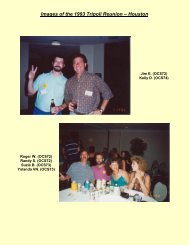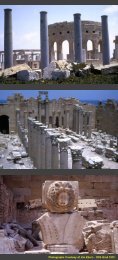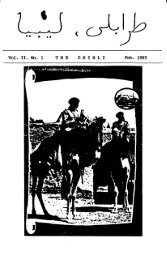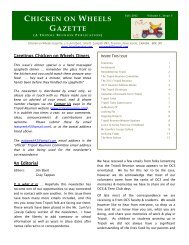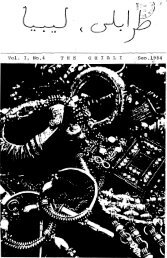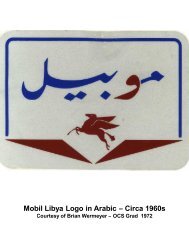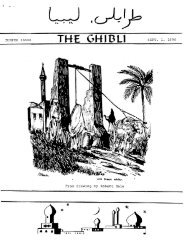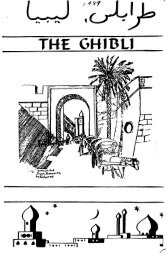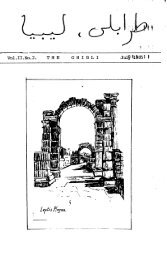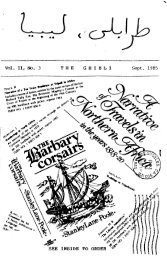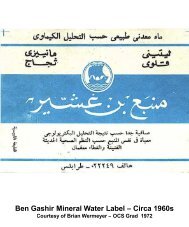Oil Companies School (OCS) A Brief History - the Tripoli Reunion ...
Oil Companies School (OCS) A Brief History - the Tripoli Reunion ...
Oil Companies School (OCS) A Brief History - the Tripoli Reunion ...
Create successful ePaper yourself
Turn your PDF publications into a flip-book with our unique Google optimized e-Paper software.
<strong>Oil</strong> <strong>Companies</strong> <strong>School</strong> (<strong>OCS</strong>)<br />
A <strong>Brief</strong> <strong>History</strong><br />
The <strong>Oil</strong> <strong>Companies</strong> <strong>School</strong> (<strong>OCS</strong>) was<br />
established in 1958. In its first year of<br />
operation it was housed in a villa in<br />
Giorgimpopoli, an expanding suburb west<br />
of <strong>Tripoli</strong>, Libya. The initial mandate of<br />
<strong>OCS</strong> was to provide an American style<br />
educational program to <strong>the</strong> children of oil<br />
company, medical, & consular<br />
employees, within a rapidly expanding<br />
Libyan oil industry. There were 50<br />
children attending <strong>OCS</strong> in this inaugural<br />
year. Within a year <strong>the</strong> students & faculty<br />
were moved to a complex of classrooms<br />
and offices located approximately 1 block<br />
north of <strong>the</strong> current <strong>OCS</strong> campus. All grades at <strong>OCS</strong> were taught from <strong>the</strong>se classrooms until <strong>the</strong> spring<br />
of 1964. The school‟s first Principal was Mr. Robert Waldum (from 1958-1964). Mr. Waldum became <strong>the</strong><br />
first Superintendent of <strong>OCS</strong>, holding <strong>the</strong> post from 1964-1974. “<strong>OCS</strong> was modeled after a typical<br />
American public school with a superintendent, principals, and a school board comprised of<br />
representatives from five major oil companies: Oasis, Occidental, Amoseas, Mobil, and Esso.” (Andrews<br />
p.12). It was under Mr. Waldum‟s tutelage that <strong>OCS</strong> developed from a one villa schoolhouse into a<br />
sprawling complex of classrooms, offices, & athletic facilities, and became a highly accredited American<br />
overseas school.<br />
In <strong>the</strong> 1962 to1963 school year <strong>the</strong>re were a total of 13 classes of elementary students, 118 Jr. High<br />
students with a graduating class of 35 Grade 9 students. During <strong>the</strong> 1963 and 1964 school years,<br />
student enrollment rose to 450 students and <strong>the</strong>n to 750 students. This rapid enrollment increase<br />
prompted <strong>the</strong> <strong>School</strong> Board to plan and implement <strong>the</strong> construction of a new school complex of<br />
classrooms and facilities, thus creating a new <strong>OCS</strong> campus.
Construction of <strong>the</strong> new <strong>OCS</strong> campus was started in 1963 and was sufficiently completed by <strong>the</strong> spring of<br />
1964 to house <strong>the</strong> Jr. High students. By 1967 <strong>the</strong> single story elementary school wings and <strong>the</strong><br />
gymnasium complex were also completed. By 1969/1970 a two<br />
story classroom building was added to <strong>the</strong> elementary school.<br />
An <strong>OCS</strong> teacher, recounts: “The physical plant of <strong>the</strong> school<br />
consisted of seven single story rectangular wings and a two<br />
story elementary building, all arranged in a giant “L.” Each wing<br />
had five rooms, all opening to <strong>the</strong> outdoors and connected by a<br />
covered sidewalk. Off by itself stood a large gymnasium and<br />
beside it, an athletic field. A parking lot completed <strong>the</strong> complex.<br />
The whole campus was enclosed by a concrete block wall …<br />
The building exteriors were neat, clean, and freshly painted in<br />
pale blue. The grounds sported one of <strong>the</strong> best crops of<br />
precious grass in <strong>Tripoli</strong>.” (Andrews p.12)<br />
These construction projects, <strong>the</strong> addition of faculty, and <strong>the</strong><br />
availability of newer expanded facilities allowed for <strong>the</strong><br />
broadening of academic, scholastic, athletic & recreational<br />
programs used by <strong>the</strong> student body & faculty.
The 1964 Ambassador records that a typical classroom day for a Jr. High school student was: “seven,<br />
forty-five minute classes a day, from 8 A.M. to 2:30 P.M. Lunch break is from 12 - 12:55 P.M.” By <strong>the</strong><br />
late 1960s, <strong>the</strong> school day was<br />
extended from 7:45 A.M. to 3:30<br />
P.M., Monday to Thursday and<br />
from 8:00 A.M. to noon on Fridays.<br />
<strong>OCS</strong> operated from early<br />
September to early June each year<br />
with approximately 3 months off in<br />
<strong>the</strong> summers.<br />
Jr. High Hallway – 1971<br />
Photograph Courtesy of Gray Tappan<br />
In 1967, <strong>the</strong> <strong>Tripoli</strong> Little League<br />
was formed and at one time<br />
boasted to be <strong>the</strong> largest American<br />
Little League outside <strong>the</strong> United<br />
States. By <strong>the</strong> late 1960s <strong>the</strong>re<br />
were 18 baseball teams spread<br />
across 3 divisions: Minor, Major, &<br />
Babe Ruth.<br />
Also in 1967 <strong>the</strong> Teen Club began operations as an extension of <strong>the</strong> <strong>OCS</strong> community. During <strong>the</strong> school<br />
year <strong>the</strong> Teen Club operated as <strong>the</strong> location for weekly dances and as a weekend recreational facility<br />
complete with beach, swimming, tennis courts, snack bar, and BBQs. During <strong>the</strong> summer months it is<br />
where all <strong>the</strong> <strong>OCS</strong> Jr. High & visiting Sr. High school kids hung out. It was much better than <strong>the</strong> mall.<br />
During <strong>the</strong> 1960s and 1970s organized athletics were a significant part of <strong>OCS</strong> life.<br />
There was <strong>the</strong> formation of <strong>the</strong> Girls Athletic Association, <strong>the</strong> boys Varsity Basketball<br />
team, and <strong>the</strong> cheerleading squads. Intramural sport leagues and teams for boys & girls<br />
soccer, football, softball, volleyball, basketball, and field hockey were developed making<br />
full use of <strong>the</strong> gymnasium and playing fields. These organized sports, along with track<br />
& field competitions provided opportunity for <strong>OCS</strong> athletes to excel and become<br />
members of <strong>the</strong> Lettermen‟s Club.<br />
By 1970 <strong>the</strong>re were more than 900 students attending kindergarten through to grade 9, with over 60<br />
teachers, administrative and support staff. In addition to academic & athletic programs, sizable and<br />
accomplished Drama, Art, Band, Choir and Journalism programs developed. The numerous plays,<br />
concerts, and displays became a major part of life and entertainment at <strong>OCS</strong> for student, faculty and<br />
parents. By this time <strong>the</strong> school also housed a sizable library for research and general reading.<br />
In 1971 a lighting system for <strong>the</strong><br />
playing fields was constructed and<br />
installed, marshalling in a new era of<br />
athletics at <strong>OCS</strong>. The lights were<br />
attached to welded frames, and were in<br />
turn welded to oil well casing pipe (an<br />
additional contribution by <strong>the</strong> oil<br />
companies). <strong>Tripoli</strong> Little League<br />
games were now scheduled for<br />
Thursday & Friday evenings in addition<br />
to <strong>the</strong> Friday afternoon and weekend<br />
games. The first night game took place<br />
on April 1, 1971. In addition, adult<br />
softball leagues sprang up with <strong>the</strong><br />
increased availability of playing time<br />
under <strong>the</strong> lights.<br />
Lights on <strong>the</strong> Playing Fields - 1971<br />
Photograph Courtesy of Gray Tappan<br />
1971 brought <strong>the</strong> departure of some of our good friends whose parents were in <strong>the</strong> employ of Esso. The<br />
compound that Esso built in Marsa Brega, become operational and had its own school.
From <strong>the</strong> 1950s to <strong>the</strong> 1980s, <strong>OCS</strong> was a predominately expatriate student population, and during <strong>the</strong><br />
period from 1958 until <strong>the</strong> mid 1970s <strong>the</strong> majority of students were American. However, by 1975 this had<br />
changed and according to <strong>the</strong> 1975<br />
Ambassador “At one time, Americans<br />
comprised over 90% of <strong>the</strong> school's population.<br />
That percentage is nearer 50 now. A more<br />
cosmopolitan atmosphere prevails which allows<br />
for a wider range of opportunities.” As a result<br />
of this, an ESL (English as a Second Language)<br />
program was also implemented.<br />
Jr. High Wings - 1971<br />
Photograph Courtesy of Gray Tappan<br />
In <strong>the</strong> 1974-1975 school year Home Economics<br />
was added to <strong>the</strong> curriculum, lunch was moved<br />
to <strong>the</strong> gym, a 9 period class schedule<br />
introduced, and a girls‟ dress code was<br />
implemented. I suspect <strong>the</strong> latter change was<br />
not well received in <strong>the</strong> student body.<br />
The 1981/1982 school year proved to be one of <strong>the</strong> most significant and easily <strong>the</strong> most turbulent year for<br />
<strong>OCS</strong>. In December 1981, <strong>the</strong> U.S. government ordered all U.S. citizens to leave Libya in advance of<br />
pending embargos and sanctions. As a result, a significant portion of <strong>the</strong> student population and a<br />
majority of faculty left at this time. The remaining administration reacted quickly, backfilled <strong>the</strong> faculty with<br />
Canadian teachers and administrators, and switched <strong>the</strong> school to a Canadian based curriculum.<br />
Excerpts from <strong>the</strong> 1982 Ambassador best describe <strong>the</strong> impact <strong>the</strong> events had on students and staff alike.<br />
“A Farewell Message<br />
Dear teachers,<br />
We have finished <strong>the</strong> 1982 school year at last. It has been a long road, full of obstacles,<br />
disappointments, and sadness. Our new teachers have done <strong>the</strong>ir best, picking up where you left<br />
off, but it is not easy to replace years of friendship, understanding and love in a few short months.<br />
We are grateful to <strong>the</strong>se people who arrived full of good will and enthusiasm, and who overcame<br />
serious difficulties of all kinds to help us finish <strong>the</strong> academic year. Although we welcomed <strong>the</strong>m<br />
and really tried to adapt quickly, it was so hard to get used to different ideas, different methods,<br />
and a different relationship with different people. Our time toge<strong>the</strong>r at <strong>OCS</strong> is gone forever, but<br />
our memories will always be a part of us. Even now, we remember our “family” with fondness,<br />
and we look upon our years toge<strong>the</strong>r as <strong>the</strong> best ever. You have given us a part of yourselves<br />
and a path to follow in our lives. Our wish for you all is one of happiness and success. We miss<br />
you.<br />
With love, Your students”<br />
This was followed up by a message from <strong>the</strong> Canadian Superintendent:<br />
“As I look out at our graduates, I am mindful of <strong>the</strong> fact that those of us who came from Canada<br />
just a few short months ago have quickly come to appreciate <strong>the</strong>se fine young people. Our<br />
thoughts must go to <strong>the</strong> great host of American teachers who, over <strong>the</strong> years, have made a very<br />
significant contribution to this school. They pioneered <strong>the</strong> development of <strong>OCS</strong>, built it, gave it<br />
spirit, traditions, strength, and its uniqueness. We appreciate <strong>the</strong> heritage of those American<br />
teachers who are still represented here by such people as Gloria Weber, Skender and Carol<br />
Brame, and Barbara Bishr. I wish to pay tribute tonight to those teachers of <strong>the</strong> past who have<br />
had such an influence on our graduating class. I know <strong>the</strong>y will be thinking of you tonight, and<br />
wishing <strong>the</strong>y could be here. I have received a telegram from former Superintendent John<br />
Monson, and his wife „The very best wishes to you, now and in your future. We miss you, <strong>the</strong><br />
o<strong>the</strong>r students, faculty, parents and <strong>OCS</strong> very much.‟”
The 1980s brought significant change to <strong>OCS</strong>. Sal Elkadiki who attended <strong>OCS</strong> 1982-1985 penned <strong>the</strong><br />
following:<br />
“… I attended <strong>OCS</strong> from 1982 until 1985. The only major event I witnessed was <strong>the</strong> transition of<br />
<strong>OCS</strong> from an American to a Canadian system. In 1981, Reagan ordered all US workers in Libya<br />
to leave <strong>the</strong> country and as a result we saw all of our American friends and teachers leave in<br />
exodus and suddenly (1982) all <strong>the</strong> teachers were Canadian. I recall it was difficult for everyone.<br />
Some teachers had been at <strong>OCS</strong> for a very long time with <strong>the</strong>ir kids born and raised in Libya.<br />
In 1984, <strong>OCS</strong> started offering 10th grade and I was one of <strong>the</strong> first students to study in this<br />
program. The 1984-85 year was a lot of fun as <strong>the</strong> 9th and 10th graders were all one gang.<br />
I visited <strong>the</strong> <strong>OCS</strong> campus in 1995 and found that everything was still <strong>the</strong> same, <strong>the</strong> class rooms,<br />
<strong>the</strong> gym (rebuilt in 1982), <strong>the</strong> lockers, even <strong>the</strong> water fountains by <strong>the</strong> junior-high washrooms<br />
were still <strong>the</strong>re. I asked about <strong>the</strong> gate keeper known as "Mohammed" and was told that he had<br />
passed away in 1993. Most of you probably remember Mohammed as he has been guarding <strong>the</strong><br />
<strong>OCS</strong> gates for decades.” (Elkadiki)<br />
From 1985-1995 <strong>OCS</strong> likely continued to operate<br />
under a Canadian school curriculum. However, in<br />
1986 <strong>the</strong> school was renamed College of US<br />
Aggression Martyrs (CUSAM). At present <strong>the</strong>re is<br />
little o<strong>the</strong>r information available of this time period,<br />
or about any of <strong>the</strong> significant events that may<br />
have occurred affecting <strong>the</strong> lives of <strong>the</strong> <strong>OCS</strong><br />
student body and faculty.<br />
Gym Complex<br />
Source - Rien<br />
In 1995 <strong>the</strong> school chose to switch to an Irish<br />
Leaving Certificate program, complying with <strong>the</strong><br />
same rules and regulations as Irish schools, with<br />
some compromises, such as students being<br />
allowed to take Arabic instead of Gaelic.<br />
Instruction in English continued to prevail.<br />
In 2005, excerpts from Internet blogs and short news stories in <strong>the</strong> Irish Times newspaper gives us a<br />
glimpse of <strong>OCS</strong>/ISM operations in this year.<br />
In June 2005, a blogger writes (referencing a June 6, 2005 Irish Times report):<br />
“Forty-five students at <strong>the</strong> International <strong>School</strong> in <strong>Tripoli</strong>, Libya, will sit <strong>the</strong> Leaving Certificate this<br />
June. Under <strong>the</strong> desert sun, <strong>the</strong>y will apply <strong>the</strong>mselves to <strong>the</strong> very same papers as <strong>the</strong> 60,000 or<br />
so youngsters who will take <strong>the</strong> exams here in Ireland … We have students from 52 countries<br />
studying at our school,” said Donna McPhee, principal of <strong>the</strong> International <strong>School</strong> … The Irish<br />
Leaving Certificate programme offered us <strong>the</strong> kind of academic standard and subject spread that<br />
we were looking for. As a Canadian myself, I consider <strong>the</strong> Irish secondary education curriculum to<br />
be far superior to <strong>the</strong> Canadian, US or UK models … McPhee contends that <strong>the</strong> Irish exam<br />
system maintains rigorous academic standards and serves stronger students well …<strong>Tripoli</strong> is <strong>the</strong><br />
only location outside <strong>the</strong> Irish state where <strong>the</strong> Leaving Cert is held on an annual basis, and <strong>the</strong><br />
school is charged with complying with <strong>the</strong> same rules and regulations as Irish schools, with some<br />
compromises. For example, students are allowed to take Arabic instead of Irish … The 45<br />
candidates in <strong>Tripoli</strong> will take <strong>the</strong>ir papers at exactly <strong>the</strong> same time as <strong>the</strong>ir Irish counterparts and<br />
completed exam scripts will be returned to <strong>the</strong> State Examinations Commission in Athlone for<br />
marking.” (Rien)<br />
The Blog continues with <strong>the</strong> following statistics about <strong>the</strong> school:<br />
“Situated on a five-acre campus, <strong>the</strong> Martyrs <strong>School</strong> consists of 11 buildings, 47 classrooms, a<br />
14,000 volume library, 2 science labs, a computer lab, auditorium, infirmary, gymnasium, and<br />
tennis courts. Students are grouped according to <strong>the</strong>ir abilities, with an accelerated study<br />
program available for gifted students. The school year lasts from September to June … In
addition to its traditional curriculum, <strong>the</strong> Martyrs <strong>School</strong> offers an extracurricular program that<br />
includes gymnastics, computers, yearbook, school newspaper, field trips, drama, student council,<br />
soccer, tennis, floor hockey, basketball, softball, volleyball, and numerous social clubs.” (Rien)<br />
In 1994, CUSAM was renamed to International <strong>School</strong> of Martyrs (ISM).<br />
In February 2011 Mary Fitzgerald, a reporter of <strong>the</strong> Irish Times writes:<br />
“One of <strong>the</strong> quirkier facets of <strong>the</strong> relationship between Libya and Ireland is <strong>the</strong> fact students at <strong>the</strong><br />
ISM international school in <strong>Tripoli</strong> sit <strong>the</strong> Leaving Cert … In 1995, school officials settled on <strong>the</strong><br />
Irish exam system as <strong>the</strong> best option for <strong>the</strong>ir multinational student body.” (Fitzgerald – Irish<br />
Times)<br />
In 2011, <strong>the</strong> website for <strong>the</strong> ISM International <strong>School</strong>, <strong>Tripoli</strong>, indicates that <strong>the</strong> school is still in operation<br />
and offers instruction for ages 4-19, still in English, with a faculty of 48 full time teachers. Enrollment is<br />
reported to be 250 boys and 200 girls, although it is not clear if <strong>the</strong>se are target numbers or actual<br />
enrollment figures. (ISM 5)<br />
Satellite View of <strong>the</strong> <strong>OCS</strong>/CUSAM/ISM Campus, August 2010 – Source Google Earth
Superintendents:<br />
Robert Waldum 1964-1974<br />
John McCuan 1974-1976<br />
John Monson 1976-1982<br />
Len Sampson 1982<br />
Mohammed Badr 1982-198x<br />
Principals:<br />
Robert Waldum 1958-1965<br />
Donna McPhee 1995<br />
Brendan Coffey 1990-1998<br />
Jr. High Principals:<br />
Assistant Principal Spencer Lewis 1964-1965<br />
Robert Engebretson 1965-1966<br />
Sam Whipple 1966-1970<br />
Jim Everingham 1970-1974<br />
William Matthais 1974-1975<br />
John Monson 1975-1976<br />
Michael Corcoran 1976-1978<br />
Russell Larsen 1978-1981<br />
John Ovens 1981-1982<br />
W.R.B. Church 1982-1983<br />
Elementary Principals:<br />
Assistant Principal Earl Cartland 1964-1965<br />
Spencer Loomis 1965-1966<br />
John Monson 1966-1970<br />
Herbert Hylbert 1970-1972<br />
John McCuan 1973-1977<br />
Charles Marino 1977-1980<br />
Donald Shoemaker 1980-1982<br />
Niall Nelson 1981-82<br />
Rob Kruse 1982-198x<br />
An <strong>OCS</strong> Chronology<br />
1958 <strong>OCS</strong> established – operates from a villa<br />
1959 <strong>OCS</strong> moves into first classroom complex<br />
1961 First school newspaper rolls off <strong>the</strong> press<br />
1963 <strong>OCS</strong> Alma Mater penned by Lynne Birney,<br />
music by Ca<strong>the</strong>rine Fornari<br />
1963/64<br />
o Student Newspaper renamed and starts<br />
publishing as The Pipeline<br />
o First Yearbook published<br />
o Girls Athletic Association (GAA) formed<br />
o Founding of <strong>the</strong> National Junior Honor Society<br />
(NJHS) and first inductees<br />
o Intramural, Journalism, Drama, Glee Club &<br />
Band programs formalized<br />
o First cheerleader squad<br />
o First Varsity Basketball Team<br />
1964 Jr. High moves into classrooms wings on <strong>the</strong><br />
new <strong>OCS</strong> campus<br />
1965 Lettermen‟s Club established<br />
1966 Safety Patrol founded<br />
1967 <strong>Tripoli</strong> Little League formed<br />
1967 Gym and elementary wings completed<br />
1967 Teen Club begins operations<br />
1969/70 Addition of 2 - double story classroom<br />
wings for elementary<br />
1971 Lights erected on playing fields<br />
1975 student population hits 50% American, 50%<br />
o<strong>the</strong>r expatriate and Libyan<br />
1980 Gymnasium destroyed by fire on Dec 12 th<br />
1981 Gymnasium re-opens<br />
1981 Ronald Reagan orders Americans to leave<br />
Libya<br />
1982 <strong>OCS</strong> moves to a Canadian based curriculum<br />
and staffed predominately with Canadian faculty<br />
1984 Grade 10 added<br />
1986 <strong>OCS</strong> renamed to CUSAM (College of US<br />
Aggression Martyrs)<br />
1994 school renamed to ISM (International <strong>School</strong><br />
of Martyrs)<br />
1995 switched from <strong>the</strong> Canadian Curriculum to<br />
<strong>the</strong> Irish Leaving Certificate program<br />
1995-present Still in operation … <strong>the</strong> mailing<br />
address is still PO Box 860, <strong>Tripoli</strong>, Libya<br />
Sources<br />
1. Andrews, Eleanor F. Letters From <strong>Tripoli</strong> - And Stops Along <strong>the</strong> Way, 2003.<br />
2. Elkadiki, Sal <strong>OCS</strong> Website, 2011.<br />
3. Fitzgerald, Mary Trade one of our many links with Libyans - Irish Times, February 22, 2011.<br />
4. Google Earth, 2011.<br />
5. ISM International <strong>School</strong>, <strong>Tripoli</strong>, Libya Website, 2011.<br />
6. <strong>OCS</strong> Ambassador, 1963-1966, 1967, 1969, 1971-1983.<br />
7. Rien Globetrotting: A Voyage to <strong>the</strong> Unkown, Internet Blogpost , 2006.<br />
8. Tappan, Gray <strong>OCS</strong> Photographs - Circa 1971.<br />
9. Tappan, Gray Satellite Photograph - February 1966.



